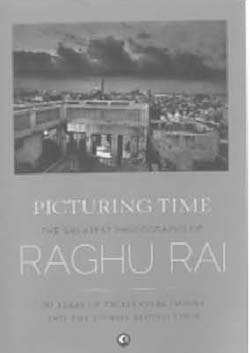‘I went from one platform to another looking for my picture before I came across these three men calmly sitting and reading their newspapers’ commented Raghu Rai in his explanation to an amazing image that juxta poses frenetic motion with an absolute indifference to the chaos around. Motion is represented by a flurry of blurred figures while the readers are clearly in view, the sharp image picking up the furrowed brow of the perhaps myopic man who holds his paper at a distance. It is Churchgate Station, Mumbai in the nineties and Rai waits for his moment to record a calm focus amidst the ‘human deluge’.
Rai’s relentless if not quirky search for the Cartier-Bressonian moment is what makes Rai one of the contemporary world’s most perceptive visual recorders. What else can explain his choice of the moment when the Dalai Lama concentrates not on a sermon but on wrapping his shawl around him correctly? Or of a rag picker sifting through election posters in front of a wall advertising the government’s family planning campaign? It is 1977 and Mrs. Indira Gandhi has just lost the elections following the Emergency. Among the detritus, there is a torn poster of a smiling Mrs. Gandhi—but to the man, it is perhaps only another piece of recyclable material. The black and white photograph is more evocative of the end of an unenviable phase of our recent history than the many words in print that followed.
In his brief introduction to this collection ‘of exceptional photographs and the stories behind him’ brought out by Aleph to commemorate 50 years of Raghu Rai’s engagement with the camera, he tells us that he started life as an engineer. It was when he moved to Delhi to live with his older brother, well-known photographer S. Paul, that his life with the print media and the camera began. Photography soon became the medium that mediated between Rai and darshan, the experiencing of reality in its entirety. Stints with The Statesman, Hindustan Times, India Today and images in The Times and Guardian followed together with over twenty books and numerous exhibitions of his work at home and abroad. Most images in the book are in black and white, the photographer’s preferred medium, though there are interleaves in colour as well. Some are iconic, seen before images, others are less known.

